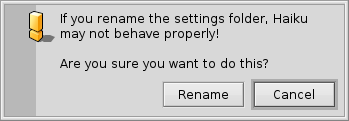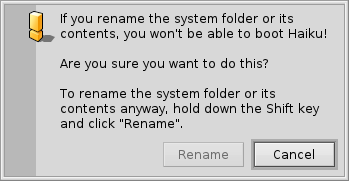Иерархия файловой системы
Иерархия файловой системы Haiku очень простая. По возможности используются понятные названия для файлов и папок для того, чтобы не вводить пользователя в замешательство. Важные для системы файлы и папки защищены от случайного изменения, предупреждая следующим образом:


Второе предупреждение появляется в случае, если Вы попытаетесь удалить или переименовать что-нибудь в иерархии системы. Для того чтобы активировать кнопку "" нужно удерживать клавишу SHIFT.
Generally, there are two separate branches springing from the root folder of the boot volume:
| /boot/system/ | Contains system files and applications/packages shared by all users. | |
| /boot/home/ | This is your personal folder where you keep your data and settings and the applications/packages that are not shared by all users. |
As long as Haiku isn't multi-user, this distinction between shared and not-shared applications/packages has no apparent effect, as there's only one user with one home folder. But since there will be support for more users than one eventually, it makes sense to learn the right way from the start.
 Системная папка - /boot/system/
Системная папка - /boot/system/
Under Haiku's predecessor BeOS, this folder was named /boot/beos/. You may still find it in some older documentation (e.g. in the original BeBook).
Most of the folders inside /boot/system/ are read-only, which is sensible as they contain the files necessary for Haiku to function correctly and therefore have to be safe from (accidental) alteration. The only user-writable folders are:
| /boot/system/cache/ | Contains cached files and the temporary folder linked to /tmp/. | |
| /boot/system/non-packaged/ | Contains a hierarchy for files that aren't part of a .hpkg (probably from old BeOS archives). | |
| /boot/system/packages/ | Besides holding Haiku's system packages, you can add/remove packages shared by all users. | |
| /boot/system/settings/ | Contains system-wide settings. | |
| /boot/system/var/ | Contains logs like the syslog (important when troubleshooting) and is the default location for the swap file. |
For more information on the packages and non-packaged folders, see topic Installing applications.
 Домашняя папка - /boot/home/
Домашняя папка - /boot/home/
This folder belongs to you. Here you can create and delete files and folders as you wish. (By the way, the tilde ("~") is a shortcut for your home folder, so you don't always have to write "/boot/home/" in Terminal.)
Files that you'd like to share with other users in a future multi-user environment have do be put outside /boot/home/. For example, you could create a folder /boot/all-users/ and put the stuff there.
| ~/Desktop/ | Holds the files of your desktop. Double-clicking won't open it, as it is already always visible. When your files happen to be obscured by open windows, just switch quickly to another Workspace. Of course, drilling down by right-clicking is also possible. | |
| ~/mail/ | This is the default location for your mails. | |
| ~/people/ | This is the default location for you contact files, see People. | |
| ~/queries/ | Queries are stored here, by default temporarily for 7 days. |
The folder /boot/home/config/ is special: just like /boot/system/ it's mostly under the control of the package management and therefore read-only. It too contains these similar user-writable folders:
| ~/config/packages/ | Here you can add/remove packages that are not shared by all users. | |
| ~/config/non-packaged/ | Contains a hierarchy for files that aren't part of a .hpkg (probably from old BeOS archives) and are not shared by all users. | |
| ~/config/settings/ | Эта папка содержит настройки для всех приложений и некоторые настройки системы. Некоторые приложения хранят свои настройки в собственных папках, другие просто хранят конфигурационные файлы прямо здесь. |
For more information on the packages and non-packaged folders, see topic Installing applications.
Here are some of the more interesting subfolders in ~/config/settings/:
| boot/ | Эта папка для хранения сценариев пользователя, которые выполняются до или после загрузки/выключения системы. | |
| boot/launch/ | Создайте ссылку на приложение или документ в этой папке, и при каждой загрузке они будут запускаться. | |
| beos_mime/ | В этой MIME -базе данных Haiku отслеживает все типы файлов и их настройки (примечание: MIME - Multipurpose Internet Mail Extension — многоцелевые расширения интернет-почты, произносится как «майм»). | |
| deskbar/menu/ | Copied or linked to files/folders/queries in this folder appear in the Deskbar menu. | |
| kernel/drivers/ | Здесь располагается один из файлов с настройками, которые могут быть интересны: файл kernel предлагает некоторые низкоуровневые настройки, например, отключение SMP, активация APM. Вы можете активировать настройки путем удаления символа комментария "#". Будьте осторожны! | |
| Tracker/ | Здесь располагаются несколько интересных папок: | |
| DefaultFolderTemplate/ | Показывает и упорядочивает все атрибуты и размеры окна по вашему вкусу. Каждая новая папка, которую вы создадите, будет использовать этот шаблон. | |
| DefaultQueryTemplates/ | Вы можете определить формат окна результатов поиска для определенных типов файлов. Для более подробного изучения следует обратиться к теме запросы: Окно результатов поиска.. | |
| Go/ | Поместите сюда ссылки на ваши избранные папки, и вы их увидите в диалогах открытия и сохранения. Для более подробного изучения следует обратиться к теме графический интерфейс Haiku: Избранные и недавно открытые папки. | |
| Tracker New Template/ | Добавьте шаблон для любого типа файла, который впоследствии будет доступен в меню файлового менеджера menu. Для более подробного изучения следует обратиться к теме Tracker - Файловый менеджер: Работа с файлами. |
 Русский
Русский Français
Français Deutsch
Deutsch Italiano
Italiano Español
Español Svenska
Svenska 日本語
日本語 Українська
Українська 中文 [中文]
中文 [中文] Português
Português Suomi
Suomi Slovenčina
Slovenčina Magyar
Magyar Português (Brazil)
Português (Brazil) Català
Català English
English